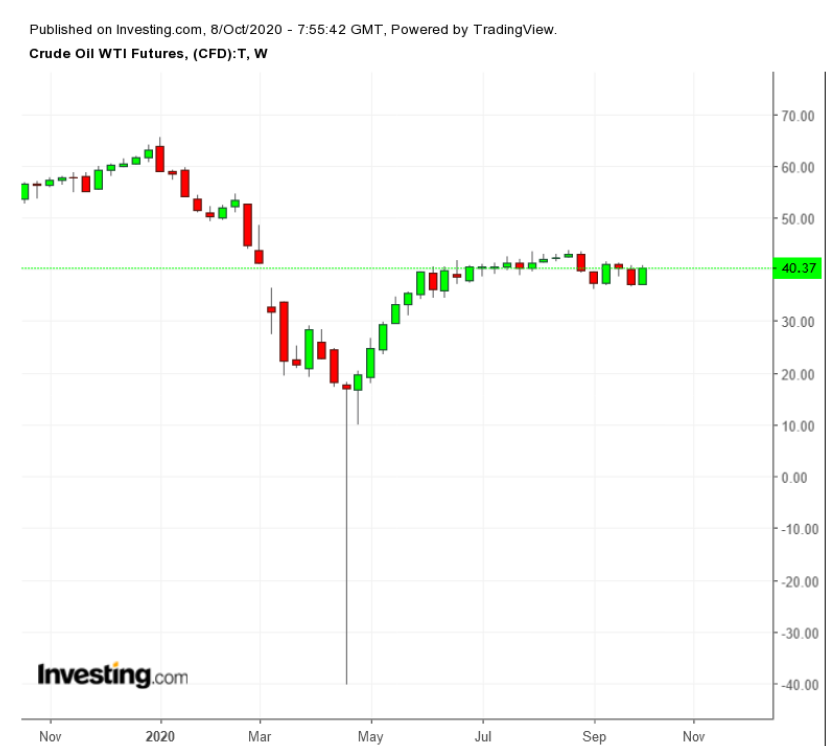Early in the week, both Brent and WTI prices fell, but they've since recovered.
Since June, both benchmarks have stayed within a tight range—around $40 per barrel—while occasionally seesawing 5% higher or lower, then settling back down. It seems like both benchmarks have been tethered to the $40 level.

Are there are any indicators signaling that oil is poised to separate from that four-month-long range? Here are five key factors for traders to watch this week, next week and into the future.
1. Economic Stimulus in the U.S.
The prospect of another U.S. stimulus deal has been whipsawing financial markets for weeks now. With little movement between Democrats and Republicans towards an agreement, on Tuesday, President Donald Trump tweeted that he told negotiators to stop talks for another stimulus deal until after the election.
The perception is that a stimulus package will help the economy, but the potential for it to animate oil demand is actually pretty minimal. Even a bailout for the airline industry is unlikely to lift jet fuel consumption much, since people are still scared to travel. Because of coronavirus lockdowns, opportunities for leisure and entertainment are limited and travel for work remains curtailed.
The President says he's open to negotiating piecemeal stimulus (as opposed to comprehensive) legislation, so equity markets regained some optimism on Wednesday. Still, oil traders shouldn’t count on stimulus funding to jumpstart oil demand.
Traders should be careful not to assume that economic stimulus will mean increased oil demand. Though of course, oil demand is the factor that will move the oil market.
2. Hurricane Delta
The storm weakened slightly as it passed over Mexico’s Yucatan Peninsula, but it's expected to strengthen as it approaches the Louisiana coastline. It is possible that the hurricane will make landfall on Friday in the same oil refinery-heavy region along the Texas-Louisiana coast that was hit by Hurricane Laura at the end of August.
Phillips 66 (NYSE:PSX) has delayed the restart of its Lake Charles, Louisiana refinery due to Hurricane Delta. The refinery, which processes 260,000 bpd of oil was shut before Hurricane Laura and has not yet restarted due to damage from the hurricane. This just slightly lowers oil demand in the U.S.
Oil companies began evacuating offshore oil rigs and moving dynamic rigs out of the hurricane’s path earlier this week. According to the Bureau of Safety and Environmental Enforcement (BSEE), about 80.5% of the oil production in the Gulf of Mexico—nearly 1.5 million bpd—was already offline on Wednesday. Traders should expect to see these closures reflected in next week’s EIA production numbers and possibly the following week’s numbers as well, depending on the hurricane’s course and severity.
3. Norway’s Oil Workers On Strike
Striking workers have forced the shutdown of six of Norway’s oil and gas fields as they demand higher pay. About 8% of the country’s total oil production—330,000 bpd—is currently impacted.
The strike has continued for longer than expected, and authorities are saying, “there is no solution in sight.” Though we do not know when the strike will end, we can expect supply to resume as soon as it does end.
4. Libyan Production, Exports Resume
Libyan oil is finally making its way back onto the market after civil strife totally shuttered oil wells and ports, starting in January 2020. Output hit 300,000 bpd this week, basically offsetting the decline in supply from Norway’s striking workers.
However, traders should not expect Libya’s oil production to hit its full capacity just yet, as the national oil company is demanding that all “rebels” be removed from the premises of certain fields before production in those places can restart. Nevertheless, exports have already resumed. A supertanker chartered by Royal Dutch Shell (NYSE:RDSa) was set to load oil from a Libyan port on Oct. 3.
OPEC had benefited from the Libyan oil disruption, and now Libyan oil production is something that OPEC will have to address. Still, Libyan oil production won’t show up on the September compliance numbers that the JMMC will consider next week, but Libya should come into play when OPEC considers its October compliance data.
5. OPEC+ Drama Brewing?
OPEC and OPEC+ will be holding their next ministerial meetings on Nov. 30 and Dec. 1. It's possible the larger group will face growing disunity from non-OPEC members.
Last March, Russia refused to go along with Saudi Arabia’s desired cut, which led to a Saudi reaction and, ultimately, a period of very low oil prices. Now, dissent is coming from South Sudan, which says it wants to renegotiate its OPEC+ quota.
The African country was only producing 140,000 bpd when it joined the OPEC+ agreement in 2016, but it wants to eventually increase production to 350,000 bpd. It has overproduced its quota by an average of 46,000 bpd between May and August.
Typically, smaller producing countries have been at a disadvantage in OPEC as larger producers have more power. South Sudan is not big enough or powerful enough to bring down the entire agreement.
OPEC+ will pressure the African nation to curb its 46,000 bpd excess production and will not support South Sudan’s goals of further increasing production. South Sudan will have to choose between remaining in the cartel and what its leadership feels is best for the country's economy and oil industry.
Of course, South Sudan can simply leave the group. But they may actually be looking for something other than increased production.
For instance, the country may seek financing and/or expertise from other group members to help revive its oil industry and achieve higher production in the coming years. If that's the case, South Sudan may be looking to use its 46,000 bpd of overproduction to bargain with OPEC+ players who care about full compliance for future benefits.
So, traders shouldn’t jump on this news as a sign of trouble brewing for the OPEC+ agreement. Nonetheless, they should keep an eye on it over the next two months.
